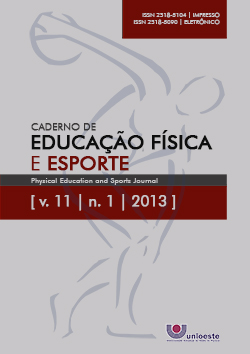Measurement of distance, average and maximum speed in a game in wheelchair rugby: pilot study
DOI:
https://doi.org/10.36453/2318-5104.2013.v11.n1.p57Keywords:
Tetraplegia, Assessment, Rugby, WheelchairAbstract
The aim of this study was to analyze the intensity of effort during a wheelchair rugby match in two athletes with spinal cord injury and functional classification 1.0 and 2.5 from the team of ADEACAMP / UNICAMP - Campinas / SP. The variables for analysis were the quantification of the traveled distance; average speed and maximum speed collected in two wheelchair rugby games. Data were quantified by the manufacturer cycle computer model velo8 Cateye ®. The values obtained between athlete A and B were 4.8 Km / h and 3.0 Km / h for the mean velocity, 8.55 Km / h and 14.95 Km / h for maximum speed, 2.98 Km and 4.83 Km for the total traveled distance, respectively. Thus, it was observed that the results displayed a high volume and intensity of play by the athlete A with related to the athlete B. As well, it also presented a higher regularity between values analyzed in the two games. This type of analysis may enable coaches’ actual values during training, seeking individualized training for athletes from different functional classifications, escaping from the empiricism, which is displayed to be so present in several teams training.
Downloads
References
BARFIELD, J. P. Exercise intensity during wheelchair rugby training. Journal of Sports Sciences, London, v. 28, n. 4, p. 389-398, 2010.
BORIN, J. P.; PRESTES, J.; MOURA, N. A. Caracterização, controle e avaliação: limitações e possibilidades no âmbito do treinamento desportivo. Treinamento Desportivo, Curitiba, v. 8, n. 1, p. 6-11, 2007.
BORIN, J. P; GOMES, A. C; LEITE, G. S. Preparação desportiva: aspectos do controle da carga de treinamento nos jogos coletivos. Revista da Educação Física/UEM, Maringá, v. 18, n. 1, p. 97-105, 2008.
COSTA, L. O. P; SAMULSKI, D. M. Overtraining em atletas de alto nível-uma revisão literária. Revista Brasilei¬ra de Ciência e Movimento, Brasília, v. 13, n. 2, p. 123-134, 2005.
DI ALENCAR, T.; A. M.; DE SOUSA, M. K. F.; SIQUEIRA, L. A. R.; SILVA, M. D. M. P. Overtraining/Overuse em ciclistas e seu retorno ao esporte. Revista Movimenta, Goiânia, v. 3, n. 1, 2010.
INTERNATIONAL WHEELCHAIR RUGBY FEDERATION (IWRF). Disponível em: http://iwrf.com/Layper-son%20Guide%20to%20Classification.pdf. Acesso em: 03 abr. de 2012.
LEMAY, V.; ROUTHIER F.; NOREAU L.; PHANG S. H.; GINIS K. A. Relationships between wheelchair skills, wheelchair mobility and level of injury in individuals with spinal cord injury. Spinal Cord, Avenel, v. 50, n.1, p. 37-41, 2012.
MASON, B. S.; VAN DER WOUDE, L. H. V.; GOOSEY-TOLFREY, V. L. The Ergonomics of Wheelchair Confi¬guration for Optimal Performance in the Wheelchair Court Sports. Sports Medicine, v. 43, n. 1, p. 23-38, 2013.
MAYNARD, F. M.; BRACKEN, M. B.; CREASEY, G.; DITUNNO, J. F. J. R.; DONOVAN, W. H.; DUCKER, T. B.; GARBER, S. L.; MARINO, R. J.; STOVER, S. L.; TATOR, C. H. ; WATERS, R. L.; WILBERGER, J. E.; YOUNG, W. International standards for neurological and functional classification of spinal cord injury. Spinal Cord, Avenel, v. 35, p. 266-274,1997.
MULROY, S. J.; FARROKHI S; NEWSAM C.J.; PERRY J . Effects of Spinal Cord Injury Level on the Activity of Shoulder Muscles During Wheelchair Propulsion: An Electromyographic Study. Archives of Physical Medicine and Rehabilitation, v. 85, p. 925-934, 2004.
SARRO, K. J.; SILVATTI, A. P. ; ALIVERTI, A. ; BARROS, R. M. L. . Proposition and evaluation of a novel me¬thod based on videogrammetry to measure 3D ribs motion during breathing. Journal of Applied Biomechanics, v. 25, p. 247-252, 2009.
SARRO, K. J.; SILVATTI, A. P.; ALIVERTI, A.; BARROS, R. M. L. de. Tracking of wheelchair rugby players in the 2008 Demolition Derby final. Journal of Sports Sciences, London, v. 28, n. 2, p. 193-200, 2010.
SZOLLAR, S. M.; MARTIN, E. M. E. Bone mineral density and indexes of bone metabolism in spinal cord injury. American Journal of Physical Medicine & Rehabilitation, Baltimore, v. 77, p. 28-35,1998.
VAN DER WOUDE, L. H. V.; BAKKER, W. H.; ELKHUIZEN, J. W.; VEEGER, H. E.; GWINN, T. Aerobic work capacity in elite wheelchair athletes: Across-sectional analysis. American Journal of Physical Medicine & Reha¬bilitation, Baltimore, v. 81, 261–271, 2002.
VERKHOSHANSKY, Y. Entrenamiento deportivo. Barcelona: Martinez Roca, 1990.
YILLA, A.; SHERRILL, C. Validating the Beck Battery of Quad Rugby Skills Tests. Adapted Physical Activity Quarterly, Champaign, v.15, n. 2, p.155-167, 2006.
Downloads
Published
How to Cite
Issue
Section
License

This work is licensed under a Creative Commons Attribution-NonCommercial-ShareAlike 4.0 International License.
Os direitos autorais permitem descarregar, compartilhar, copiar, distribuir, adaptar, transformar, exibir, reproduzir a totalidade ou partes do artigo para qualquer propósito legal, desde que não tenha fins lucrativos e seja citada a fonte.
Informamos que todo o conteúdo do texto publicado, e dos seus possíveis erros ortográficos e gramaticais, é de inteira responsabilidade de seus autores, não cabendo ao Caderno de Educação Física e Esporte, ou aos nossos Avaliadores Ad Hoc, por qualquer implicação legal ou por eventual negligência à língua portuguesa ou à estrangeira.



















